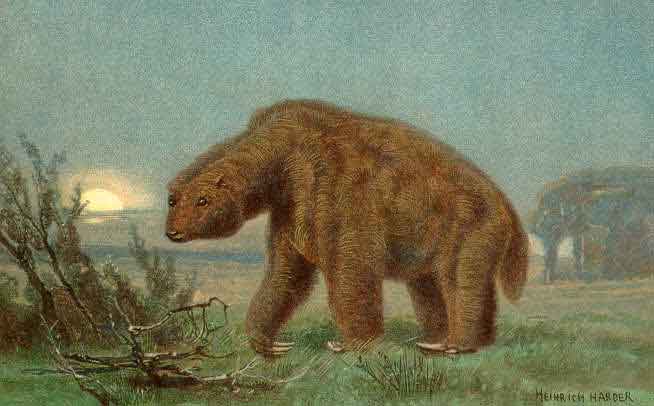Megatherium Cladus: Eukaryota Name Megatherium Cuvier, 1796 Megatherium ("Great Beast") was a genus of elephant-sized ground sloths endemic to Central America and South America that lived from the Pliocene through Pleistocene existing approximately 5.3 million years.[1] Its size was exceeded by only a few other land mammals, including mammoths and the even larger Paraceratherium. The rhinoceros-sized Promegatherium is suggested to be the ancestor of Megatherium. Characteristics
Megatherium had a robust skeleton with a large pelvic girdle and a broad muscular tail. Its large size enabled it to feed at heights unreachable by other contemporary herbivores. Rising on its powerful hind legs and using its tail to form a tripod, Megatherium could support its massive body weight while using the curved claws on its long forelegs to pull down branches with the choicest leaves. Its jaw is believed to have housed a long tongue, which it would then use to pull leaves into its mouth, similar to the modern tree sloth. Some recent morpho-functional analysis[2] indicates that M. americanum was adapted for strong vertical biting. The teeth are hypsodont and bilophodont, and the sagittal section of each loph is triangular with a sharp edge. This suggests the teeth were used for cutting, rather than grinding, and that hard fibrous food was not the primary dietary component. Richard Fariña and Ernesto Blanco of the Universidad de la República in Montevideo have analysed a fossil skeleton of M. americanum and discovered that its olecranon - the part of the elbow to which the triceps muscle attaches - was very short. This adaptation is found in carnivores and optimises speed rather than strength. The researchers say this would have enabled M. americanum to use its claws like daggers.[3] They suggest that to add nutrients to its diet, Megatherium may have taken over the kills of Smilodon. Based on the estimated strength and mechanical advantage of its biceps, it has been proposed that Megatherium could have overturned adult glyptodonts (large, armored xenarthrans, related to armadillos) as a means of scavenging or hunting these animals.[3] However, other zoologists have described this proposal as "fanciful".[4] Habitat Megatherium inhabited woodland and grassland environments of the lightly wooded areas of South America.[5] Distribution Megatherium lived in parts of South America, where it was an endemic species, as recently as 10,000 years ago. An example of these most recent finds is at Cueva del Milodon in Patagonian Chile.[6] The closely related genus Eremotherium lived in more tropical environments further north, and in North America Habits
Diet and feeding habits
While it has been suggested that the giant sloth may have been a carnivore, this is still a controversial claim.[7] It is depicted as both a herbivore and a scavenger in the BBC documentary Walking with Beasts. It is depicted as an omnivore in the Animal Planet special Giant Monsters. In another BBC documentary, Prehistoric America, Megatherium is depicted as an herbivore. Evolution The ground sloths, as with all other xenarthrans, evolved in isolation in South America, while it was an island during the Paleogene. During the Pliocene, the Central American Isthmus formed, causing the Great American Interchange, and a mass extinction of much of the indigenous South American megafauna. Ground sloths were largely unaffected and continued to thrive in spite of competition from the northern immigrants. In fact, ground sloths were among the various South American animal groups to migrate northwards, into North America, where they remained and flourished until the late Pleistocene.[8] In the south, the giant ground sloth flourished until about 10,000 years ago. Most cite the appearance of an expanding population of human hunters as the cause of its extinction. The oldest (and smallest) species of Megatherium is M. altiplanicum of Pliocene Bolivia.[9] It was very similar to the Miocene ground sloth, Promegatherium, and was about the size of a rhinoceros. Species of Megatherium became larger and larger, with the largest species, M. americanum of the late Pleistocene, reaching the size of an African Elephant.
^ A. E. Zurita, A. A. Carlini, G. J. Scillato-Yané and E. P. Tonni. 2004. Mamíferos extintos del Cuaternario de la Provincia del Chaco (Argentina) y su relación con aquéllos del este de la región pampeana y de Chile. Revista geológica de Chile 31(1):65-87
Bargo, M. S. (2001). "The ground sloth Megatherium americanum: Skull shape, bite forces, and diet". Acta Palaeontologica Polonica 46 (2): 173–192. Retrieved 2010-07-05.
Source: Wikipedia, Wikispecies: All text is available under the terms of the GNU Free Documentation License |
|


